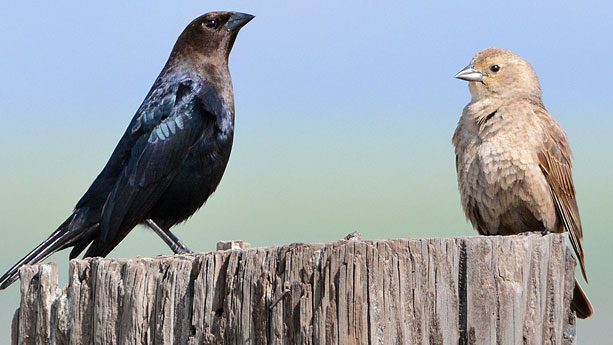If Brown-headed Cowbirds are reared by other species, how do they know they are cowbirds when they grow up?

Brown-headed Cowbirds are nest parasites, meaning the females lay their eggs in the nests of smaller birds. Each cowbird chick is raised by “foster parents” of another species. Yet instead of flocking with others of the species that raised them, the young cowbirds begin congregating with other cowbirds in advance of their first winter. So how do they gain their sense of identity?
It’s a question that behavioral scientists are still working out. It seems that cowbirds learn to recognize each other both through sound and sight, and by comparing the outside world to themselves. Juvenile Brown-headed Cowbirds and even nestlings respond to the sounds of their own species, especially the chatter call. One study found that six-day-old cowbird chicks can already tell the call of an adult cowbird from similar sounds made by other adult birds. In fact, the begging call that nestling cowbirds use to get food from their foster parents is acoustically similar to the chatter call. It’s possible that by listening to itself, a young cowbird gets its first clues as to what other cowbirds sound like.
A separate study discovered that juvenile cowbirds inspect their own appearance to compare with other individuals they encounter—scientists marked the feathers of some young cowbirds and found that these birds chose to associate with adult cowbirds that bore the same artificial markings in preference to unmarked cowbirds.
All of this recognition has to happen in the first few months of a cowbird’s life—the period when the young birds leave their foster nest and join groups of other cowbirds. A third experiment kept young cowbirds in cages with canaries for their first winter. At the end of the winter, the cowbirds were singing canary-like songs and courting the canaries.
There are probably other ways that cowbirds—and other brood parasites—learn to recognize their species. And there may be an innate, or genetic, component to recognition as well. We’ll just have to wait to see what the behavioral ecologists find out next.
- Read more about Brown-headed Cowbirds on All About Birds
- Listen to Brown-headed Cowbird calls and videos from the Cornell Lab’s Macaulay Library.

All About Birds
is a free resource
Available for everyone,
funded by donors like you
American Kestrel by Blair Dudeck / Macaulay Library
